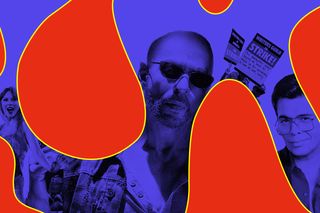
The Year in Authenticity
Shah Rukh was back, Barbie gave us joy, Animal tapped into anger -- but are any of these as authentic as they seem?

In an interview with Jia Tolentino a few months ago, prominent left academic Naomi Klein said: “whenever you don’t like reality, you can just say it’s not real.” She was talking about a growing tendency in the far right to fashion alternate realities when the present is untenable, which isn’t too different from what the liberals or even the left are doing (citing attending Barbie as an example).
It’s been a year of trying to find the real and the authentic, but ending up in the wrong places. Instagram, it’s safe to say, has definitively killed celebrities. We’re foisted with disillusionment over nepo babies, said nepo babies are mediated to us through several layers of PR, and an older generation of stars has receded into the safety of their post-fame solitude. The culture writer Anne Helen Petersen pointed out before: celebrities have become their own paps, except they get to carefully control and sanitize their own images.
Nowhere was that more evident than the new season of Koffee With Karan, in which at once beloved yet frequently villainized Bollywood producer Karan Johar interviewed a new set of entrants into the industry along with some usual suspects. The result, however, was carefully calibrated diplomacy and political correctness – all snark, sass, and pizzazz, hints of authenticity in celebrities' otherwise carefully calibrated lives, wiped clean from the platter. One moment from the show reveals that Johar himself is aware, and plodding through the fatigue: it’s when his guest Kiara Advani chirpily narrates the story of what her husband, Siddharth Malhotra, calls her parents. A quip about Johar’s age momentarily makes the mask slip: he tries to move on from the story, bored of it, predicting its end (“yes yes, he calls them mom and dad”). The banality of celeb culture was long in the making but seems to have arrived in earnest this year. Everyone is married, all the weddings took place on Instagram, there is nothing left to see or hear about except for the little trivialities of domestic life. It’s arguably the end of the talk show – and all talk shows – as we know it. Once again, none of it feels real.
This year was preceded by several turbulent ones: the nepotism debate (that began on Koffee), Sushant Singh Rajput’s death by suicide, the saffronization of Bollywood – these were cultural gears that set into motion an era of blankness, blandness, and give-us-nothing-ness. The essence of celebrity, stardom: celestial beings you yearn to get closer to, to know about, to experience, has disappeared. We’re only left with the vague impression of what once was. Like AI, Insta-PR today confuses the line between reality and fiction.
Many in the business of making entertainment have offered one version of a solution to this problem: a return to the universal story, feeling, and experience; one that supposedly, everyone irrespective of their identity or location can relate to, which signifies the real human condition. This was a characteristic theme across several films: nearly everything tried to capture a universal feeling rather than explore a specific one, lest it risk the common internet gripe of not representing a very specific lived experience. This universalism as authenticity was heavily awarded this year. RRR’s “Naatu Naatu” brought all the major awards home because of its claim to a simplistic, universal decoloniality, cloaked in a veneer of authenticity to make it look specific enough: “naatu naatu,” in Telugu, literally means raw, indigenous, homegrown. Authentic but vague enough to be universal. Universality almost represented what’s real, authentic, and genuine about our collective stories.
Then there was Barbie, which was about the reclamation of an authentic girlhood writ large. Taylor Swift – the patron saint of confessional authenticity – had the biggest year of her career yet. Her Eras Tour broke several records, quickly on its way to making performance history. The Eras Tour movie saw young women and girls across theaters – in India and elsewhere – get up from their seats, dance and sing along with joyful abandon. Swift spoke to the universal feeling of love, heartbreak, joy, and celebrated that universalism; offering a web of interconnectedness in a world constantly rending us apart. Both Taylor Swift and Barbie tapped into a universal feeling: women yearn to go outside, to shape and remake the world in our own images.
But probe a little further and you find that image has been fed to us already. It’s the image of the White, abled, beautiful, and ultimately out of reach woman: pristine, plastic, perfect. Clearly, the universal is not real. Moreover, in our enthusiastic claim over public space and out of the confines of the domestic private, we forgot to acknowledge a 101 point: public–private divide never materially existed for working class, marginalized women anyway. So why did we buy these experiences as authentic girlhood and joy?
On the other end of the spectrum is Animal. Enough has been said about the film’s misogyny – but what explains its enormous box office success? Almost as a response to the collective girlification of the movies was a vindictive collective response to shut it down. Animal represented the fantasy of authentic emotion through violence – obfuscating the discourse, sending critics in a tailspin. Its premise, it seemed, was based on a man unfettered by faux politeness or rules which get in the way of his potent rage: he becomes an animal, the ultimate form of uncontrolled expression of the inner, subterranean self. This is a blank slate for a legion of men in the Andrew Tate era to claim a particular brand of masculinity, an angry one that isn’t afraid of violence. But this, too, is a universalist pitch, because the idea of anger and rage unleashed by the relaxation of civil norms suggests the existence of that much bloodlust in the first place – a dark, violence, and unjust ideal for men. If Barbie gave us authentic fun, joy and levity, Animal marked the return of authentic violence and anger. All of it made us feel something. Depending on who you are, one or the other made you feel good. Maybe they even made you cry. And as film critic Caitlin Quinlan wrote in Art Review, “if it makes you cry it must be good.” Crying, after all, is the ultimate signifier of authentic emotions – only actors can really fake it. But does the mere eliciting of strong emotions mean that the art itself is worthy?
Mainstream “art” claiming to be good on the premise that it draws out emotions is a dishonest enterprise. Quinlan weighed in on the tendency toward universalism in culture and films in particular, noting with hesitation how it might be reshaping our relationship with the medium itself. “These films all took from their audiences without giving much back, leaning into the notion of audience self-recognition as effective storytelling. They forwent specificity in favour of scope, asking viewers to project their own experiences and feelings onto a blank canvas narrative,” Quinlan wrote.
In a way, Shah Rukh Khan also made his comeback this year in this way: a universalist icon, the long-lost hero, the superstar who is also a blank slate upon whom everybody can project everything. There was endless discourse on what his return means, endless dissections of signs and symbols all searching for what it all means. What he means. Is he even real? Is his seemingly political declaration in Jawan authentic? At the time of writing this, he is about to release his third film for the year, a hat-trick of a comeback in a country deprived of his open arms and his signature charisma, democratic and ever-available for anybody who desires it. But he’s more of an enigma than ever – in the absence of his familiar overtures of love in his films, he’s more of a blank slate than ever. We asked for authenticity, we got anonymity.
This, too, is arguably a response to a political climate completely hostile to difference or specificity. Shah Rukh’s retreat was a response to a cultural rejection of his identity. The ongoing universalization of culture isn’t too far from the national project of homogenization: One Nation, One Culture, One Vote, One Everything. The tendency to want to cater to everyone ends up flattening what makes people human: individuality. Everything is always about something political or something universal – leading to the Adipurushes and the Kerala Stories of the country. At the risk of being trite, however, we’ve lost diversity – true, uncomfortable, diversity – and the friction (read: texture) that comes with it. Even stories that lay claim to diversity – as Dahaad and others did – are about the diversity. People, their lives, their specificities, are rendered into facile political plot-drivers. And so nothing is ever about anything at all. But as the critic Parul Sehgal wrote in The New Yorker, “Plot and originality count for crumbs if a writer cannot bring the unhappy lady to life.”
The cracks in this year of faux-authenticity are beginning to show. Recently, comedian Hasan Minaj was questioned for allegedly doing the same thing every film and pop culture moment was doing this year: appealing to the universality of racism by embellishing his stories with enough plot and set-ups about race and diaspora. In grappling with that other big question – how we differentiate ourselves from AI bots – truth-telling becomes more urgent than ever. But if we only ever care about plots, and plots about vaguely large enough themes like identity and politics can be so easily constructed and replicated, perhaps AI can replace us after all.
This existential dread about art isn’t inseparable from politics. In searching for the correct plot, we have lost the plot. That’s perhaps why, as of writing this piece, the Lok Sabha has just passed the Bharatiya Nyaya (Second) Sanhita, 2023, and it barely went noticed. This is a code of laws intended to replace the existing framework of criminal laws, written in Hindi in a bid to claim authentic nationhood, claiming to represent the decolonial update to the colonial framework it replaces. Our search for meaning and authenticity led to a grotesque Frankenstein progeny: the universal Hindu laws for the universally (upper caste) Hindu state. In accepting universality as an answer to authenticity as a legitimate premise, we’ve allowed the cultural chauvunists to define the universal for us. The real artists and activists are in jail; the rest of us are toothless to challenge this.
But maybe there’s something more hopeful underneath the surface, and perhaps we find our way back to authenticity through difference. Hopefully this – wherever we are – is not real, and not just because we don’t like the reality.
Rohitha Naraharisetty is a Senior Associate Editor at The Swaddle. She writes about the intersection of gender, caste, social movements, and pop culture. She can be found on Instagram at @rohitha_97 or on Twitter at @romimacaronii.
Related


Woe Is Me! "I Keep Losing Friends Every Year. Am I the Problem?"
